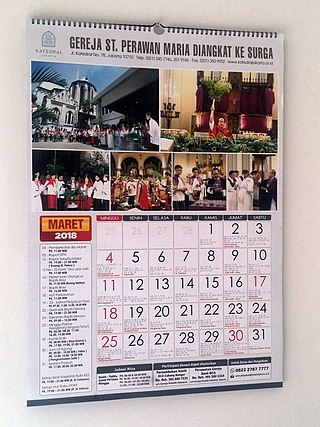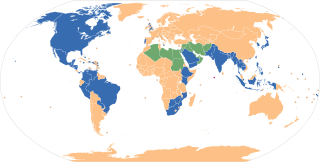Related Research Articles

A calendar is a system of organizing days. This is done by giving names to periods of time, typically days, weeks, months and years. A date is the designation of a single and specific day within such a system. A calendar is also a physical record of such a system. A calendar can also mean a list of planned events, such as a court calendar or a partly or fully chronological list of documents, such as a calendar of wills.
Generally speaking, a calendar year begins on the New Year's Day of the given calendar system and ends on the day before the following New Year's Day, and thus consists of a whole number of days. A year can also be measured by starting on any other named day of the calendar, and ending on the day before this named day in the following year. This may be termed a "year's time", but not a "calendar year". To reconcile the calendar year with the astronomical cycle certain years contain extra days. The Gregorian year, which is in use in most of the world, begins on January 1 and ends on December 31. It has a length of 365 days in an ordinary year, with 8760 hours, 525,600 minutes, or 31,536,000 seconds; but 366 days in a leap year, with 8784 hours, 527,040 minutes, or 31,622,400 seconds. With 97 leap years every 400 years, the year has an average length of 365.2425 days. Other formula-based calendars can have lengths which are further out of step with the solar cycle: for example, the Julian calendar has an average length of 365.25 days, and the Hebrew calendar has an average length of 365.2468 days. The Islamic calendar is a lunar calendar consisting of 12 months in a year of 354 or 355 days. The astronomer's mean tropical year, which is averaged over equinoxes and solstices, is currently 365.24219 days, slightly shorter than the average length of the year in most calendars.
Intercalation or embolism in timekeeping is the insertion of a leap day, week, or month into some calendar years to make the calendar follow the seasons or moon phases. Lunisolar calendars may require intercalations of both days and months.
The Julian calendar is a solar calendar of 365 days in every year with an additional leap day every fourth year. The Julian calendar is still used in parts of the Eastern Orthodox Church and in parts of Oriental Orthodoxy as well as by the Berbers, whereas the Gregorian calendar is used in most parts of the world.
A leap year is a calendar year that contains an additional day added to keep the calendar year synchronized with the astronomical year or seasonal year. Because astronomical events and seasons do not repeat in a whole number of days, calendars that have a constant number of days in each year will unavoidably drift over time with respect to the event that the year is supposed to track, such as seasons. By inserting ("intercalating") an additional day or month into some years, the drift between a civilization's dating system and the physical properties of the Solar System can be corrected. A year that is not a leap year is a common year.
The International Fixed Calendar is a proposed calendar reform designed by Moses B. Cotsworth, first presented in 1902. The solar calendar divides the year into 13 months of 28 days each. A type of perennial calendar, every date is fixed to the same weekday every year. Though it was never officially adopted at the country level, the entrepreneur George Eastman instituted its use at the Eastman Kodak Company in 1928, where it was used until 1989. While it is sometimes described as the 13-month calendar or the equal-month calendar, various alternative calendar designs share these features.

A week is a unit of time equal to seven days. It is the standard time period used for short cycles of days in most parts of the world. The days are often used to indicate common work days and rest days, as well as days of worship. Weeks are often mapped against yearly calendars, but are typically not the basis for them, as weeks are not based on astronomy.
The World Calendar is a proposed reform of the Gregorian calendar created by Elisabeth Achelis of Brooklyn, New York in 1930.
A solar calendar is a calendar whose dates indicate the season or almost equivalently the apparent position of the Sun relative to the stars. The Gregorian calendar, widely accepted as a standard in the world, is an example of a solar calendar. The main other types of calendar are lunar calendar and lunisolar calendar, whose months correspond to cycles of Moon phases. The months of the Gregorian calendar do not correspond to cycles of the Moon phase.
Calendar reform or calendrical reform is any significant revision of a calendar system. The term sometimes is used instead for a proposal to switch to a different calendar design.
The determination of the day of the week for any date may be performed with a variety of algorithms. In addition, perpetual calendars require no calculation by the user, and are essentially lookup tables. A typical application is to calculate the day of the week on which someone was born or a specific event occurred.

A perpetual calendar is a calendar valid for many years, usually designed to look up the day of the week for a given date in the past or future.

The Doomsday rule, Doomsday algorithm or Doomsday method is an algorithm of determination of the day of the week for a given date. It provides a perpetual calendar because the Gregorian calendar moves in cycles of 400 years. The algorithm for mental calculation was devised by John Conway in 1973, drawing inspiration from Lewis Carroll's perpetual calendar algorithm. It takes advantage of each year having a certain day of the week upon which certain easy-to-remember dates, called the doomsdays, fall; for example, the last day of February, 4/4, 6/6, 8/8, 10/10, and 12/12 all occur on the same day of the week in any year. Applying the Doomsday algorithm involves three steps: Determination of the anchor day for the century, calculation of the anchor day for the year from the one for the century, and selection of the closest date out of those that always fall on the doomsday, e.g., 4/4 and 6/6, and count of the number of days between that date and the date in question to arrive at the day of the week. The technique applies to both the Gregorian calendar and the Julian calendar, although their doomsdays are usually different days of the week.
The Symmetry454 calendar (Sym454) is a proposal for calendar reform created by Irv Bromberg of the University of Toronto, Canada. It is a perennial solar calendar that conserves the traditional month pattern and 7-day week, has symmetrical equal quarters in 82% of the years in its 293-year cycle, and starts every month on Monday.
The Pax calendar was invented by James A. Colligan, SJ in 1930, as a perennializing reform of the annualized Gregorian calendar.
The solar cycle is a 28-year cycle of the Julian calendar, and 400-year cycle of the Gregorian calendar with respect to the week. It occurs because leap years occur every 4 years, typically observed by adding a day to the month of February, making it February 29th. There are 7 possible days to start a leap year, making a 28-year sequence.
The ISO week date system is effectively a leap week calendar system that is part of the ISO 8601 date and time standard issued by the International Organization for Standardization (ISO) since 1988 and, before that, it was defined in ISO (R) 2015 since 1971. It is used (mainly) in government and business for fiscal years, as well as in timekeeping. This was previously known as "Industrial date coding". The system specifies a week year atop the Gregorian calendar by defining a notation for ordinal weeks of the year.
The Gregorian calendar is the calendar used in most parts of the world. It was introduced on February 24 with a papal bull, and went into effect in October 1582 by Pope Gregory XIII as a modification of, and replacement for, the Julian calendar. The principal change was to space leap years differently so as to make the average calendar year 365.2425 days long, more closely approximating the 365.2422-day 'tropical' or 'solar' year that is determined by the Earth's revolution around the Sun.
The Hanke–Henry Permanent Calendar (HHPC) is a proposal for calendar reform. It is one of many examples of leap week calendars, calendars that maintain synchronization with the solar year by intercalating entire weeks rather than single days. It is a modification of a previous proposal, Common-Civil-Calendar-and-Time (CCC&T). With the Hanke–Henry Permanent Calendar, every calendar date always falls on the same day of the week. A major feature of the calendar system is the abolition of time zones.
A perennial calendar is a calendar that applies to any year, keeping the same dates, weekdays and other features.
References
- ↑ "Leap Week Calendars". www.hermetic.ch. Retrieved 2023-05-17.